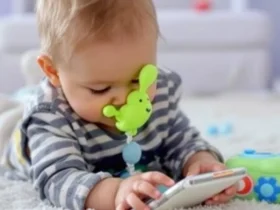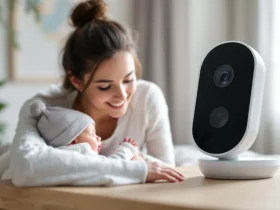The Evolving Landscape of Baby Tech
The Jetsons of Parenthood: Smart Gadgets for Modern Babies – For decades, the tools of parenthood remained relatively static. Diapers, bottles, and cribs were the cornerstones of infant care, with incremental improvements rather than revolutionary changes. However, the 21st century has witnessed a dramatic shift, propelled by rapid advancements in technology and a growing consumer demand for sophisticated, data-driven solutions to parenting challenges.
This has resulted in a burgeoning market of “smart” baby products designed to monitor, analyze, and optimize various aspects of infant development and well-being.The increasing popularity of smart baby products stems from several key factors. Firstly, the heightened awareness of infant safety and health has driven a demand for real-time monitoring capabilities.
Secondly, the proliferation of connected devices and the Internet of Things (IoT) has made it easier and more affordable to integrate technology into the home environment. Thirdly, the desire for data-driven insights into infant behavior and development has fueled the adoption of products that track sleep patterns, feeding schedules, and other vital metrics.
Finally, the convenience and peace of mind offered by these technologies are powerful incentives for busy parents.
Technological Transformations in Parental Experiences
Technology is fundamentally altering the parental experience, offering both benefits and challenges. For instance, smart baby monitors with video and audio capabilities allow parents to remotely observe their infants, providing a sense of security and enabling quicker responses to distress signals.
Smart cribs can track sleep patterns, offering data that can inform decisions about sleep training and identify potential sleep disorders. Smart feeding systems can help parents track the amount of milk or formula consumed, ensuring adequate nutrition. Wearable sensors monitor vital signs like heart rate and temperature, alerting parents to potential health issues.
However, it is important to note that the reliance on technology also necessitates a critical evaluation of data privacy and the potential for information overload. The sheer volume of data generated by these devices can be overwhelming, and parents must be discerning in how they interpret and utilize this information.
Over-reliance on technology may also detract from the importance of direct parent-child interaction and intuitive parenting skills. The responsible and balanced integration of technology remains crucial for optimizing its benefits while mitigating potential drawbacks.
Smart Feeding and Sleep Solutions

The burgeoning market for smart baby products offers parents a suite of tools designed to optimize their child’s routine, from feeding schedules to sleep patterns. While not a replacement for parental intuition and care, these technologies provide valuable data and insights that can contribute to a more efficient and potentially healthier routine for both baby and caregiver.
The key lies in understanding the capabilities and limitations of each device and integrating them thoughtfully into a holistic approach to childcare.
Smart baby products are increasingly leveraging data-driven insights to improve parental decision-making. This shift reflects a broader trend in personalized healthcare, extending the benefits of data analysis to the youngest members of the family. However, responsible implementation and a critical approach to data privacy remain crucial considerations.
Smart Baby Bottles and Feeding Systems
Smart baby bottles and feeding systems employ sensors to track feeding volume, frequency, and even temperature. This data can be valuable for parents seeking to establish consistent feeding patterns and monitor their baby’s intake. For example, a smart bottle might alert parents if their baby hasn’t consumed enough milk within a certain timeframe, prompting them to offer additional feedings.
However, the reliance on technology should not replace the importance of visual cues and direct interaction with the baby during feeding. Over-reliance on these devices could inadvertently hinder the development of intuitive parental awareness. Some systems may also be prone to inaccuracies, necessitating careful calibration and cross-referencing with traditional methods.
The cost of these systems can also be a significant barrier to entry for many parents.
Smart Sleep Trackers and Sleep Monitoring
Smart sleep trackers, often incorporated into baby monitors or wearable devices, utilize various technologies such as sound sensors, movement detectors, and even breathing monitors to track a baby’s sleep patterns. This data can reveal important insights into sleep duration, sleep cycles, and potential sleep disturbances.
This information allows parents to identify patterns and address potential sleep issues, such as colic or reflux, by working with pediatricians. For instance, a sleep tracker might identify a correlation between a particular feeding time and subsequent sleep disruptions, prompting parents to adjust their feeding schedule.
However, the accuracy of these devices can vary, and excessive reliance on them could lead to parental anxiety rather than providing genuine assistance. Moreover, data privacy concerns surrounding the collection and storage of sensitive sleep data are a valid consideration.
Apps Integrating Feeding and Sleep Data, The Jetsons of Parenthood: Smart Gadgets for Modern Babies
Several apps integrate with smart baby products to consolidate feeding and sleep data, providing a comprehensive view of the baby’s routine. These apps often generate reports, charts, and graphs that visualize trends and patterns. For example, an app might show the correlation between feeding volume and sleep duration, allowing parents to optimize their baby’s feeding schedule for improved sleep quality.
Some apps also offer personalized recommendations based on the collected data, though it’s important to approach these recommendations with critical judgment and consult with pediatricians for personalized advice. The data collected by these apps is generally stored on secure servers, but parents should always carefully review the app’s privacy policy before granting access to their baby’s sensitive data.
Examples of such apps include (but are not limited to) BabyConnect and Huckleberry, which offer features such as feeding and sleep tracking, diaper changing logs, and growth charts.
Safety and Privacy Concerns: The Jetsons Of Parenthood: Smart Gadgets For Modern Babies

The burgeoning market for smart baby products presents a double-edged sword: unparalleled convenience alongside significant safety and privacy risks. These devices, ranging from smart monitors to connected feeding systems, collect vast amounts of sensitive data about infants, raising concerns about data security breaches, unauthorized access, and the potential for misuse of personal information.
Understanding these risks and implementing appropriate safeguards is crucial for responsible parenting in the digital age.The potential for data breaches is a primary concern. Smart baby products often connect to home Wi-Fi networks and the internet, creating potential entry points for hackers.
A breach could expose sensitive data, such as sleep patterns, feeding schedules, and even video footage of the infant, potentially leading to identity theft, stalking, or other serious harms. Furthermore, the data collected might be vulnerable to unauthorized access or misuse by manufacturers or third-party service providers.
Data Encryption and Security Measures
Manufacturers employ varying levels of data encryption and security measures. Some utilize robust end-to-end encryption, ensuring that only authorized users can access the data. Others rely on less secure methods, potentially leaving data vulnerable. For instance, a company might use AES-256 encryption, a widely considered secure standard, while another might employ a weaker algorithm, making it more susceptible to hacking.
Transparency regarding the specific security protocols used is often lacking, making it difficult for parents to make informed decisions. A comparative analysis of security protocols across leading brands in the smart baby product industry is currently lacking, highlighting a need for greater standardization and independent audits.
Best Practices for Safe and Responsible Use
Parents can take proactive steps to mitigate risks associated with smart baby products. Before purchasing a device, thoroughly research the manufacturer’s privacy policy and security measures. Look for products that use strong encryption and have a proven track record of security.
Always change default passwords and use strong, unique passwords for each device. Regularly update the firmware to patch any security vulnerabilities. Consider using a separate, secure Wi-Fi network for smart baby devices, isolating them from other devices on the home network.
Limit the amount of data collected by disabling unnecessary features. And finally, be mindful of the potential risks and understand that no system is entirely foolproof. The responsible use of these technologies requires constant vigilance and informed decision-making.
Wrap-Up
The integration of smart technology into modern parenting presents both unprecedented opportunities and significant challenges. While smart baby gadgets offer unparalleled convenience and insights into a child’s development, concerns regarding data privacy and the potential for over-reliance on technology remain paramount.
Ultimately, the responsible and informed adoption of these advancements is crucial to ensuring a safe and enriching environment for both parents and their children. As technology continues its rapid evolution, navigating this landscape thoughtfully will be key to harnessing its benefits while mitigating potential risks.
FAQs
What are the potential downsides of using smart baby monitors?
Potential downsides include the risk of hacking, data breaches, and the potential for false alarms or malfunctions. Over-reliance on the monitor can also hinder intuitive parental responses to a child’s needs.
How can I ensure the privacy of my child’s data when using smart baby products?
Carefully review a product’s privacy policy before purchase. Look for strong encryption protocols and companies with a proven track record of data security. Minimize data sharing and opt out of unnecessary data collection features whenever possible.
Are smart baby toys really necessary?
Smart toys are not necessary, but they can offer engaging and interactive learning experiences. Traditional toys remain valuable and crucial for development. The decision to incorporate smart toys should be based on individual family needs and preferences, prioritizing age-appropriateness and safety.










Leave a Reply
View Comments